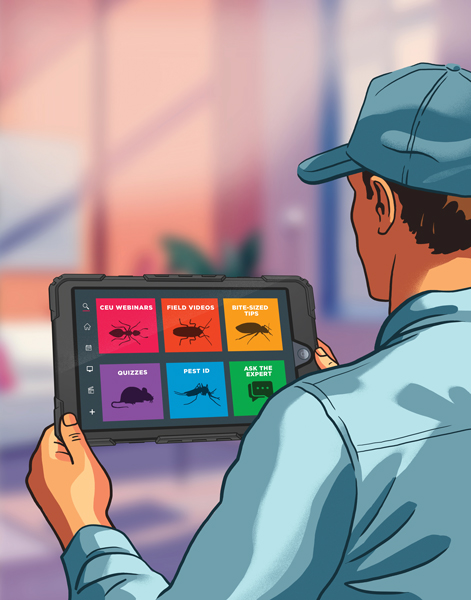
Illustration by Rob Dobi
Today’s training programs need to be comprehensive, accessible and easy for pest control technicians to understand. That’s according to Foster Brusca, “co-wrangler” of The Pest Posse in San Jose, Calif., and a Pest Management Professional (PMP) columnist.
“Training for new technicians should extend beyond one or two days, potentially lasting several weeks or even months, depending on the complexity of the accounts they will manage,” he adds. “It also should be continuous, not just during the initial on-boarding.”

Kurt Anderson
Kurt Anderson, VP of sales and co-founder of Washington, Utah-based Pest Pro University, cites statistics from business consultant Devlin Peck, who maintains 45 percent of employees are more likely to stay in their roles if they receive more training — and more than 90 percent of employees say they won’t quit if they receive development opportunities.
“The bottom line is train your people, and everyone will be happier,” Anderson says.
Consultant Sheri Spencer Bachman, PMP’s “The Business Coach” columnist, recalls how a potential client told her, “I hire technicians with experience, so I expect them to do what I hired them to do.” Yet, she says, he was confounded as to why he had high technician turnover.
“When you hire people with experience, you’re more than likely going to have to ‘untrain’ some bad habits,” Spencer Bachman continues. “There’s a lot more to training than just the technical aspects. Some companies aren’t teaching how to use the phone to complete the service, how to communicate with the office, how to answer customers’ questions. Failure to train is not setting up employees for success.”

Tom Wright
Tom Wright, ACE, president of Carrollton, Texas-based Pest Pro Academy, says the best trainers tackle pest control from an artisan perspective. “They continue to seek new knowledge and build upon the experience and wisdom they have gained so they can effectively pass it along to others,” he explains.

Laura Rosenwald
CEU Webinars
The National Pest Management Association’s (NPMA’s) training and resource center manager, Laura Rosenwald, BCE, classifies industry webinars — especially those that offer continuing education unit (CEU) credits — as a “fantastic and flexible way to convey important information to new employees.”
Dr. Nancy Troyano, BCE, director of education and training for Reading, Pa.-based Rentokil-Terminix, agrees. “CEU training via webinars promotes consistency in training because it allows all colleagues in the company to hear the same message at the same time. Consistency in training can be especially challenging for larger companies or those spread out over wide geographic areas because it’s so much harder to get everyone in the same place at once to conduct training.”

Josh Johnson
Josh Johnson, southeast coast territory manager with manufacturer Control Solutions Inc. (CSI), based in Pasadena, Texas, says there are many benefits to online training. “It’s an effective way of reaching a large industry audience without taking up their day like an off-site workshop might do,” he adds.
Earlier this year, Insects Limited opened its Center for Stored Product Protection in Westfield, Ind. “It houses a big lab, but it also has tables and screens for about 25 people in a classroom setting,” explains President Pat Kelley, BCE. “This way, if you cannot attend a training session in person, you can attend via Zoom.”
Field Videos
Cameron Riddell, president of Carson, Calif.-based Bird Barrier America, reports he and his team have made a concerted effort to keep up with training technologies.
“Back in the early 2000s, we filmed comprehensive installation videos on VHS tapes. We moved those onto DVDs, and now they are on YouTube and our website,” Riddell says.
Regardless of whether the trainer is a supplier, distributor or pest management service provider, it’s important to be more than a just “a talking head and a PowerPoint,” Riddell says. Bird Barrier’s on-site studio, ProL@bb (which stands for “Learn at Bird Barrier”), hosts both in-person workshops and online webinars and videos. “We knew to make it dynamic, we had to recreate some real-world situations,” he explains. “We installed a building façade, signage, ledges, parts of buildings — things you can teach on without having to go on a lift.” For online or video projects, he says, it gets away from static presentations, so trainers can demonstrate what they are explaining in real time.

Pat Kelley
Kelley notes that many of Insects Limited’s videos are live-streamed, not recorded. “We’re constantly tweaking our presentations based on feedback,” he says. “We have quite an extensive insect ID video library, however, that we can incorporate into training presentations as references.”
Dr. Nina Jenkins, founder and CTO of Centre Hall, Pa.-based Aprehend, teases, “We have a motto at Aprehend: ‘We guarantee poor results if you do not watch our training videos.’” Dr. Jenkins says she welcomes back-and-forth during training sessions, whether technicians are learning online or in-person. “I want them to stop me the moment a question occurs to them. If they wait 10 minutes, they might lose it because we’ve gone onto another point.”
Mark VanderWerp, BCE, manager of education and training for Troy, Mich.-based Rose Pest Solutions, cautions that videos can become dated in a very short time.
“Information changes so rapidly these days, and it takes a lot of time to record and rerecord high-quality training content,” he adds. “Documents, on the other hand, while not as dynamic of a medium, are a breeze to update and republish. It’s a good idea to combine the two to supplement each: Pull out the details from the videos that are likely to change and stick them in a companion document.”
Bite-Sized Tips
“Today’s ‘student’ has a limited attention span, so micro-learning has become an important concept in education and training,” Dr. Troyano says. “Breaking down subjects into succinct topics is ideal to capture the learner’s attention. Online content in formats such as e-learning courses and videos are best retained in 3- to 5-minute segments.”

Cameron Riddell
Riddell says it’s important to meet your audience where they are. For example, he says, Bird Barrier’s 15- to 20-minute podcasts discussing a product or technique have been popular because technicians can listen to them while driving their routes.
Johnson says apps also count as “bite-sized” training. “When I was a technician, I used to ride with the NPMA Field Guide on my front seat,” he offers as an example. “I’d often have to refer to it in the field. But the app version of the Guide makes it quick and easy to look up the information almost instantly.”
VanderWerp notes that “bite-sized” information can be as simple as a helpful hint delivered through group text messages, on shared sites, or via a Learning Management System (LMS) software program. “It’s nice to use an LMS, so the training becomes documented and retrievable,” he adds.
Quizzes
“Quizzes can be a great way to measure knowledge gaps and, when using the right technology, can even promote learning,” says Dr. Troyano. “For example, a learning ‘gamification’ app can set up quizzes so the questions answered incorrectly will be asked repeatedly until the learner answers correctly. The app not only measures knowledge on a topic, but also reinforces the learning effect while making learning fun and engaging.”

Judy Black, BCE
Judy Black, BCE, VP of Quality Assurance and Entomology for Rollins Inc. and a PMP Hall of Famer (Class of 2019), says she sees online polling during webinars, and even for audiences in in-person settings, becoming more popular in the future. “I think it’s a wonderful way to get engagement,” she adds.

Mark VanderWerp
VanderWerp points out there should be a policy in place for those who fail a post-training quiz: “Do they have to retake the training? Do they meet with their supervisor on the topic?” he asks, noting that whatever the recourse might be, make sure it’s consistently applied across the company.
Pest ID
While Google Lens and pest identification apps can be helpful, Black says, PMPs need to use them as tools, not as replacements for traditional ways of verifying a species. “There will still be times when you need to trust your training and get the staff entomologist to put a sample through the dichotomous keys,” she says.

Dr. Nina Jenkins
Dr. Jenkins points out that information sheets are as valuable now as they have been in the past. She offers bed bugs (Cimex lectularius) vs. bat bugs (C. pilosellus) as a prime example. “You can’t treat bat bugs without addressing the bats,” she explains. “What if you don’t have a wildlife license? What time of year does your state prohibit bat exclusions? You need to know what you’re dealing with before you treat it.”
VanderWerp shares his approach to familiarize new hires with the nuances of pest identification. “We start with the Top 15 pests early in technicians’ careers — German cockroach, American cockroach, pavement ant, carpenter ant, etc. — so they don’t get overwhelmed,” he explains. “Repetition is key for knowledge retention; these aren’t household names for most new employees. Having pictures is nice, but having physical samples or better yet, live specimens, is the best. I keep colonies of the common cockroaches and bed bugs for our new employee training class, for example.”
Ask the Expert
Andy Linares, owner of Bug Off Pest Control Center in New York City, advises reaching out “to the people you respect who have solid information. Academia comes in extension offices, and distributors and manufacturers that are competent to share solid, up-to-date info on new products, techniques and regulations,” he says. “Seek out the ‘proper gray matter,’ if you will.”

Charles Holt
Charles Holt, CWCP, CNI, MNI, the New Richmond, Ohio-based executive trainer for the National Wildlife Control Owners of America (NWCOA), says he’s glad there are online options for professionals who want to obtain or maintain their licenses but cannot afford the time or cost needed to go to days-long training. On the other hand, it’s important for new technicians — especially wildlife control technicians — to learn in-person from more experienced techs.
“Meetings expose these new techs to certified trainers and seasoned technicians, where the exchange of ideas and experiences can give a more fulfilling experience,” Holt adds. “Similarly, ridealongs are invaluable as both a training aid and to possibly predict a candidate’s future performance. If they aren’t asking questions, offering to help or showing interest while riding with you, what will they be like once they’re on their own?”
Black agrees. “Initial training, if done correctly, will weed out the people who aren’t going to love this job — and help develop the people who are going to love this job.”

Sheri Spencer Bachman
Spencer Bachman says smaller companies can get away without having full-time trainers, if they are smart about scheduling training sessions with manufacturer or distributor representatives.
“We had different supplier representatives for eight months of the year, and during the other four months, we had non-technical training,” she explains, noting that it might be a presentation by their medical insurance representative, a financial planner, etc. “Sales and office staff attended as well, and we had technical, sales and office teams shadow one another. It gave them empathy and perspective in their interactions with one another.”
Instill professionalism

Andy Linares
There should be a personal comportment to training, says Linares. “Dress properly, ensure your equipment is in good order — but also, smell right!” Linares admonishes, noting that everything from “vaping breath” to overenthusiastic cologne sprays can leave a bad impression on customers. “And watch your mouth! People look to us for information and talking trash does not elevate our profession.”
Those who excel in professionalism and communication just might be good candidates for becoming your official trainers, Black points out. “Your training team must be the best of the best. But don’t forget to train the trainers: On a regular basis, make sure they know the latest trends, technologies, policies, etc., so they can knowledgeably pass along the information.”

Dr. Nancy Troyano
Dr. Troyano reports that a solid field training program also can increase year-1 employee retention and customer satisfaction.
“Effective on-the-job training should include several fundamental components,” she says. “At a minimum, this includes having a structured on-the-job program and having a trained trainer to deliver the training.” She adds that other considerations should include:
▶ An organized list of critical skills for the trainee to demonstrate competency. The list should include a place for the trainer to verify the trainee’s competency.
▶ The trainer also must be certified to train in the field, and that certification process should include topics such as effective coaching, feedback and documentation, as well as communication with both the trainee and leadership.
▶ There should be compensation for the certified field trainer that consistently pays a set amount of money for each field training day, and education for leadership buy-in, to ensure roles and responsibilities of the trainer, trainee and hiring manager are clear.
Looking ahead
Linares predicts that artificial intelligence will change industry training in ways we cannot yet conceive. Still, he’s a proponent of always growing our “natural intelligence” (which coincidentally, is the theme for this year’s New York Pest Expo in November, which Linares coordinates and hosts). “Yes, rely on technology for productivity and efficiency,” he points out. “But we cannot stunt our brains.”
There is no easy answer with training, Holt asserts, adding, “Owners need to keep an open mind. I recommend that with new hires, explore free online training for vetting; if the program doesn’t offer testing, watch it yourself and create your own test for new hires to take. If they are becoming invested in the process and showing promise, then it’s time to move on to the more in-depth certified training.”
Johnson points out training will never be one size fits all. “Some people need to read the information; others learn best in person,” he adds. “The best way to train is to have all the ways to train that you can. You cannot be in an ivory tower with an attitude of ‘take what we give you.’ That will only hold you back.”

Foster Brusca
It should also be continuous, reminds Brusca: “Training should not cease once service technicians are initially trained on their routes and responsibilities. To ensure efficiency, training should be engaging
and enjoyable for service technicians.”
Ultimately, Anderson says, “everyone has to pay for training. There are demands that push unprepared techs into places they shouldn’t be. Too often, ‘training’ comes in the form of damage control after customer cancellations and callbacks because of past mistakes.”
The real challenge, says Wright, is to be an accurate arbiter and curator of the information your trainees need. “A big part of a trainer’s job is sifting through what information is the best. There’s also going to be conflicting information out there and we have to rely on our experience — and colleagues — so we are providing what our trainees need,” he concludes. “There is only so much time to train, and we have to make sure our employees are prepared for whatever comes their way.”
The future of industry training
Dr. William Robinson has made a career of training pest management professionals (PMPs), first at a pest control firm and later as an industry distributor and product representative. Now a consultant, Dr. Robinson offers his insights as to what the future holds for industry training.
“The 2020s are becoming a turning point for professional pest management. Technology is sweeping into the industry from all sides and at all levels,” he states. “The professional technician must be ready to understand the technology and then make it all work.”
The goal, he says, is to make training both interesting and useful.

Dr. William Robinson
Dr. Robinson notes new employees should be looked at as much more than being able to fill a gap in a route — while it may be true, the attitude should be one of welcoming and ensuring the new hire is in it for the long haul.
“The ‘study for the test’ approach doesn’t help the technician or the industry,” he adds. “The long-term benefit for the technician is ‘study for a career.’ Investment in technology is as important as the investment in personnel.”
Leave A Comment